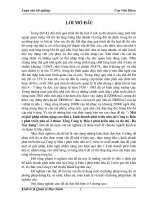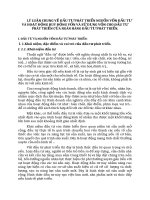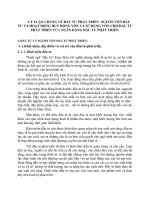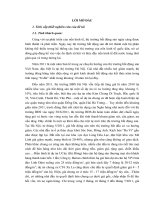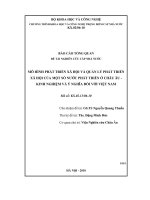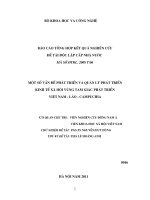Phát Triển Và Tối Ưu Hóa Tay Kẹp Chi Tiết Dạng Trục Sử Dụng Cơ Cấu Mềm.doc
Bạn đang xem bản rút gọn của tài liệu. Xem và tải ngay bản đầy đủ của tài liệu tại đây (5.33 MB, 202 trang )
MINISTRY OF EDUCATION AND TRAINING
HCM CITY UNIVERSITY OF TECHNOLOGY AND EDUCATION
HO NHAT LINH
DEVELOPMENT AND OPTIMIZATION OF GRIPPERS
FOR CYLINDER SAMPLES USING COMPLIANT
MECHANISMS
PH.D. DISSERTATION
MAJOR: MECHANICAL ENGINEERING
CODE: 9520103
Ho Chi Minh City, July 2023
MINISTRY OF EDUCATION AND TRAINING
HCM CITY UNIVERSITY OF TECHNOLOGY AND EDUCATION
HO NHAT LINH
DEVELOPMENT AND OPTIMIZATION OF GRIPPERS
FOR CYLINDER SAMPLES USING COMPLIANT
MECHANISMS
PH.D. DISSERTATION
MAJOR: MECHANICAL ENGINEERING
CODE: 9520103
Supervisor 1: Assoc. Prof. Dr. Le Hieu Giang
Supervisor 2: Dr. Dao Thanh Phong
Reviewer 1:
Reviewer 2:
Reviewer 3:
Ho Chi Minh City, July 2023
I
SCIENTIFIC CURRICULUM VITAE
I. Personal information
1. Full name: HO NHAT LINH
2. Birthday: 01/01/1982 Place of birth: Long An
3. Nationality: Vietnam
Sex: Male
4. Academic degree: Master of Engineering - 2016
5. Contact:
No.
1
Address
2
Phone/
fax
3
Office
2nd Floor, No.63, Xuan Hong
street, 12 Ward, Tan Binh District,
HCMC, Viet Nam
(+84) 944.800.004
(+84) 944.800.004
6. Education background (latest):
Level
Time
Institution
HCM University of
BS.
2005
MS.
Home
B69/4, My Hoa 2, Xuan
Thoi Dong Ward, Hoc
Mon District, HCMC,
Viet Nam
2016
Technology and Education,
Viet Nam
Ho Chi Minh City
Major/Specialty
Mechanical
Engineering
Mechanical
University of Technology,
Viet Nam
Engineering
Organization
Position
II. Work experience
Time
From
to
II
06/2005 01/2007
CÔNG TY TNHH VIE-PAN –
Mechanical Engineer
01/2007 05/2009
Việt nam
CTY TNHH IKEBA SANGYO
Mechanical Engineer
12/2012 09/2013
– Nhật Bản
CTY TNHH SEKO SANGYO
– Nhật Bản
CTY TNHH NIDEC
09/2013 Present
SEIMITSU VIET NAM
CTY TNHH KOEI VIET NAM
06/2009 10/2012
Mechanical Engineer
Mechanical Engineer
Sales engineer
III. Reference
Dr. Dao Thanh Phong
Office: Institute for Computational Science, Ton Duc Thang University
Email:
Assoc.Prof. Dr. Le Hieu Giang
Office: HCMC University of Technology and Education
Email:
Commitment: I hereby guarantee that all the above declaration is the truth and only
the truth. I will fully take responsibility if there is any deception.
Ho Chi Minh City, July 2023
Signature and Full name
Ho Nhat Linh
III
CONTENTS
CONTENTS......................................................................................................................................IV
ORIGINALITY STATEMENT..................................................................................................IX
ACKNOWLEDGMENTS..............................................................................................................X
ABSTRACT......................................................................................................................................XI
LIST OF ABBREVIATIONS....................................................................................................XII
LIST OF SYMBOLS..................................................................................................................XIV
LIST OF FIGURES...................................................................................................................XVII
LIST OF TABLES.....................................................................................................................XXII
CHAPTER 1
INTRODUCTION....................................................................................1
1.1.
Background and motivation...............................................................................................1
1.2.
Problem description of proposed compliant grippers.................................................6
1.3.
Objects of the dissertation..................................................................................................8
1.4.
Objectives of the dissertation.............................................................................................8
1.5.
Research scopes.....................................................................................................................8
1.6.
Research methods..................................................................................................................9
1.7.
The scientific and practical significance of the dissertation.....................................9
1.7.1. Scientific significance...........................................................................................................9
1.7.2. Practical significance.............................................................................................................9
1.8.
Contributions..........................................................................................................................9
1.9.
Outline of the dissertation................................................................................................10
CHAPTER 2
2.1.
LITERATURE REVIEW..............................................................................11
Overview of compliant mechanism...............................................................................11
2.1.1. Definition of compliant mechanism...............................................................................11
IV
2.1.2.
2.1.3.
Categories of compliant mechanism ...........................................................13
Compliant joints or flexure hinges ..............................................................15
2.2.
Actuators ....................................................................................................17
2.3.
Displacement amplification based on the compliant mechanism .................18
2.3.1.
Lever mechanism ........................................................................................19
2.3.2.
The Scott-Russell mechanism .....................................................................20
2.3.3.
Bridge mechanism ......................................................................................22
2.4.
Displacement sensors based on compliant mechanisms ..............................25
2.5.
Compliant grippers based on embedded displacement sensors ....................28
2.6.
International and domestic research ............................................................29
2.6.1. Research works in the field by foreign scientists ......................................... 29
2.6.1.1. Study on compliant mechanisms by foreign scientists .............................29
2.6.1.2. Study on robotic grippers and compliant grippers by foreign scientists ... 30
2.6.2. Research works in the field by domestic scientists ......................................38
2.6.2.1. Research on compliant mechanisms by domestic scientists .....................38
2.6.2.2. Research on robotic grippers and compliant grippers by domestic scientists
...............................................................................................................39
2.7. Summary ....................................................................................................
CHAPTER 3 THEORETICAL FOUNDATIONS .................................................
43
45
3.1.
Design of experiments ................................................................................
45
3.2.
Modeling methods and approaches for compliant mechanisms ................... 48
3.2.1. Analytical methods .....................................................................................
48
3.2.1.1. Pseudo-rigid-body model ........................................................................
49
3.2.1.2. Lagrange-based dynamic modeling approaches ......................................
50
3.2.1.3. Finite Element Method ...........................................................................
51
V
3.2.1.4. Graphic method, Vector method, and Mathematical analysis.........................52
3.2.2. Data-driven modeling methods........................................................................................52
3.2.3. Statistical methods...............................................................................................................55
3.3.
Optimization methods........................................................................................................56
3.3.1. Metaheuristic algorithms...................................................................................................58
3.3.2. Data-driven optimization...................................................................................................59
3.4.
Weighting factors in multi-objective optimization problems................................59
3.5.
Summary................................................................................................................................60
CHAPTER 4
DESIGN,
ANALYSIS,
DISPLACEMENT
SENSOR
FOR
AN
AND
OPTIMIZATION
ASYMMETRICAL
OF A
COMPLIANT
GRIPPER............................................................................................................................................61
4.1.
Research targets of displacement sensor for compliant gripper...........................61
4.2.
Structural design of proposed displacement sensor..................................................62
4.2.1. Mechanical design and working principle of a proposed displacement sensor .
62
4.2.1.1. Description of structure of displacement sensor..................................................62
4.2.1.2. The working principle of a displacement sensor..................................................65
4.2.2. Technical requirements of a proposed displacement sensor...................................68
4.3.
Behavior analysis of the displacement sensor............................................................68
4.3.1. Strain versus stress...............................................................................................................68
4.3.2. Stiffness analysis..................................................................................................................80
4.3.3. Frequency response.............................................................................................................82
4.4.
Design optimization of a proposed displacement sensor........................................85
4.4.1. Description of optimization problem of a proposed displacement sensor........85
4.4.1.1. Definition of design variables....................................................................................88
VI
4.4.1.2.
4.4.1.3.
Definition of objective functions ............................................................. 89
Definition of constraints ......................................................................... 90
4.4.1.4.
The proposed method for optimizing the displacement sensor ................ 90
4.4.2. Optimal Results and Discussion ...................................................................
95
4.4.2.1.
Determining Weight Factor ...................................................................... 95
4.4.2.2.
Optimal results ...................................................................................... 104
4.4.3. Verifications .............................................................................................. 108
4.5.
Summary
CHAPTER 5
..................................................................................................111
COMPUTATIONAL MODELING AND OPTIMIZATION OF A
SYMMETRICAL COMPLIANT GRIPPER FOR CYLINDRICAL SAMPLES 113
5.1.
Basic application of symmetrical compliant gripper for cylinder samples . 113
5.2. Research targets of symmetrical compliant gripper ................................... 114
5.3. Mechanical design of symmetrical compliant gripper ............................... 115
5.3.1. Description of structural design ................................................................ 115
5.3.2. Technical requirements of proposed symmetrical compliant gripper ......... 117
5.3.3. Behavior analysis of the proposed compliant gripper ................................ 117
5.3.3.1.
Kinematic analysis ................................................................................ 117
5.3.3.2.
Stiffness analysis .................................................................................. 121
5.3.3.3.
Static analysis ....................................................................................... 124
5.3.3.4.
Dynamic analysis .................................................................................. 125
5.4. Design optimization of the compliant gripper ........................................... 126
5.4.1. Problem statement of optimization design ................................................. 126
5.4.1.1.
Determination of design variables ......................................................... 127
5.4.1.2.
Determination of objective functions .................................................... 128
5.4.1.3.
Determination of constraints ................................................................. 128
VII
5.4.2. Proposed optimization method for the compliant gripper .......................... 129
5.4.3. Optimized results and validations ............................................................. 131
5.4.3.1.
Optimized results .................................................................................. 131
5.4.3.2.
Validations ........................................................................................... 136
5.5.
Summary .................................................................................................. 139
CHAPTER 6 CONCLUSIONS AND FUTURE WORKS ................................. 141
6.1.
Conclusions .............................................................................................. 141
6.2.
Future works ............................................................................................. 142
REFERENCES.................................................................................................... 143
APPENDIX......................................................................................................... 165
VIII
ORIGINALITY STATEMENT
I, Ho Nhat Linh, confirm that this dissertation is the product of my efforts, carried
out under the guidance of Assoc. Prof. Dr. Le Hieu Giang and Dr. Dao Thanh
Phong, to the best of my understanding.
The information and findings presented in this dissertation are authentic and have
not been previously published.
IX
ACKNOWLEDGMENTS
First of all, I am grateful to my adviser, Assoc. Prof. Le Hieu Giang and Dr. Dao
Thanh Phong have supported me with his knowledge and dedication throughout my
Ph.D. studies and provided me with the perspective required to conduct research in
the field of Compliant mechanisms.
I would want to thank my compliance team members, who will follow me
throughout my research career.
Also, I would like to thank for the financial support from the HCMC University of
Technology and Education, Vietnam, under Grant No. T2018-16TÐ, and Vietnam
National Foundation for Science and Technology Development (NAFOST ED) under
grant No.107.01-2019.14.
To conclude, I extend my heartfelt appreciation to my spouse and parents for their
motivation, assistance, and endurance.
Ho Nhat Linh
X
ABSTRACT
Developing a gripper with accurate grasping and positioning tasks has been a
daunting challenge in the assembly industry. To meet these requirements, this thesis
aims to develop two new types of compliant grippers. The first gripper with an
asymmetrical structure is capable of integrating displacement sensors. The second
gripper with a symmetrical structure is served for assembly. The hypothesized
grasping objects are small-sized cylinders as the shaft of the vibration motor used in
mobile phones or electronic devices ( 0.6mm×10mm).
In the first part, a displacement sensor for self-identifying the stroke of an
asymmetric compliant gripper is analyzed and optimized. Strain gauges are placed in
the flexible beams of the gripper and turn it into the displacement sensor with a
resolution of micrometers. In addition, static and dynamic equations of the gripper are
built via the pseudo-rigid-body model (PRBM) and Lagrange’s principle. To increase
the stiffness and frequency, silicone rubber is filled the open cavities of the gripper.
Taguchi-coupled teaching learning-based optimization (HTLBO) method is
formulated to solve the multi-response optimization for the gripper. Initial
populations for the HTLBO are generated using the Taguchi method (TM). The
weight factor (WF) for each fitness function is properly computed. The efficiency of
the proposed method is superior to other optimizers. The results determined that the
displacement is 1924.15 µm and the frequency is 170.45 Hz.
In the second part, a symmetric compliant gripper consisting of two symmetrical
jaws is designed for the assembly industry. The kinematic and dynamic models are
analyzed via PRBM and the Lagrange method. An intelligent computational
technique, adaptive network-based fuzzy inference system-coupled Jaya algorithm, is
proposed to improve the output responses of the gripper. The WF of each cost
function is computed. The results achieved a displacement of 3260 µm. Besides, the
frequency was 61.9 Hz. Physical experiments are implemented to evaluate the
effectiveness of both compliant grippers. The experimental results are relatively
agreed with the theoretical results.
XI
LIST OF ABBREVIATIONS
Abbreviation
Full name
CAD
Computer-aided design
FEM
Finite element method
FEA
Finite element analysis
CG
Compliant gripper
CM
Compliant mechanism
PEA
Piezoelectric actuator
MDS
Micro-displacement sensor
SR
Silicon rubber
TM
Taguchi method
ANOVA
Analysis of variance
S/N
Signal-to-Noise
AVONSNR
Average value of normalized S/N ratios
RSM
Response surface methodology
PRBM
Pseudo-rigid-body model
HTLBO
Hybrid teaching learning-based optimization
GA
Genetic algorithm
PSO
Particle swarm optimization
XII
Abbreviation
Full name
AEDE
Adaptive elitist differential evolution
ANFIS
Adaptive neuro-fuzzy inference system technique
WF
Weight factor
DA
Displacement amplification
MOO
Multi-objective optimization
MOOP
Multi-objective optimization problem
NSGA-II
Nondominated sorting genetic algorithm II
WEDM
Wire electrical discharged machining
FH
Flexure hinge
XIII
LIST OF SYMBOLS
Abbreviation
Full name
S
Safety factor
y
Yield strength of the material
f
Frequency
E
Young’s modulus
ε
Strain
σ
Stress
y
The quality response
i
The number of experiments
q
The number of replicates of experiment ‘i’
nd
The population size
X
The vector of design variables
xi
Design variable
UL,i
Upper limit of the design variable
UL,i
Lower limit of the design variable
pop
The population
r
Random value
TF
The teaching factor
XIV
Abbreviation
m(.)
Full name
Average value of the data set.
S/N
Signal-to-noise ratio
zi
Normalized mean S/N
i
S/N ratio
m
The number of responses
R
The resistance
G
Gauge factor
Vo
The output of the circuit
Vex
The excitation voltage of the circuit
Fy
Force in the y direction
S
Sensitivity
N
The number of failure cycles
Sut
The ultimate strength
Se
The endurance strength limit
M
The bending moments
dφ/ds
The differentiation of deflection
W
External work
Fi
Input force
XV
Abbreviation
Full name
Fo
Output force
kPEA
The stiffness of PEA
Fpreload
Preload force of the piezoelectric actuator
Ms
The entire mass of the gripper
Ks
The stiffness of the gripper
li
Length of the ith flexure hinge
ti
Thickness of the ith flexure hinge
W
Width of the positioning platform
L
Length of the positioning platform
H
Hight of the positioning platform
XVI
LIST OF FIGURES
Figure 1. 1: Some applications of robotic gripper [2]: a) Medicine/biology, b) Material
handling, c) Picking, packaging, and shelling, and d) Machine tending
robots. .....................................................................................................................
1
Figure 1.2: Several types of grippers in the industry [3]: a) Vacuum grippers, b)
Pneumatic grippers, c) Hydraulic grippers, d) Magnetic grippers, and e) Electric
grippers. ..................................................................................................................
2
Figure 1. 3: A miniatured vibrating motor: a) Mobile phone, b) Vibrating mobilephone motor, c) Miniatured motor [13]. ................................................................... 7
Figure 2. 1: a) Traditional rigid-body clamp and b) Compliant clamp [16]. ........ 11
Figure 2. 2: Classification of compliant mechanism based on compliance [18]. .... 13
Figure 2. 3: Classified based on the static deformation of a structure [18]. ............ 14
Figure 2. 4: A compliant active mechanism with two flexible segments [19]. ....... 14
Figure 2. 5: A passive compliant mechanism with four rigid links and a flexible link
[19]........................................................................................................................14
Figure 2. 6: Four types of typical CM : a) Inverter, b) Compliant platform, c)
Microgripper, and d) Positioning stage [20]. ..........................................................
15
Figure 2. 7: Three principal categories of FH arrangements: a) Single-axis; b)
Multiple-axis; c) Two-axis [28]. ............................................................................
16
Figure 2. 8: Complex type of FHs: a) Cross hinge, b) Cartwheel hinge, c) Leaf spring,
d) Hyperbolic hinge [28]. ......................................................................................
16
Figure 2. 9: Flexure hinges with notch shape [29]: a) Circular hinge, b) Filleted leaf
hinge, c) Elliptical hinge, d) V shape hinge, e) Hyperbolic hinge, f) Parabolic hinge.
..............................................................................................................................16
Figure 2. 10: Actuators: a) Piezoelectric actuators [34]; b) Electrostrictive actuators
[35]; c) Magnetostrictive actuators [36]; d) Shape memory alloy (SMA) actuators
[37]; and e) Pneumatic actuators [38]. ...................................................................
Figure 2. 11: Lever mechanism. ............................................................................
XVII
18
19
Figure 2. 12: Lever mechanism for in-compliant grippers: a) A hybrid amplifying
structure [39]; b) Single lever mechanism [42]; c) Serial lever mechanisms [43]; d)
Different lever mechanisms [44].................................................................................................20
Figure 2. 13: Schematic of Scott-Russell mechanism: a) The principle of operation;
b) Analysis of the amplification ratio........................................................................................21
Figure 2. 14: Application of Scott-Russell mechanism in gripper design: a) Microgripper with Scott-Russell mechanism [46]; b) A large-range micro-gripper with
Scott-Russell mechanism [47].....................................................................................................22
Figure 2. 15:
Schematic of bridge mechanism: a) Displacement of bridge
mechanism; b) Amplification factor analysis of a bridge mechanism. [48]..................23
Figure 2. 16:
Bridge mechanism for compliant grippers: a) Half of the bridge
mechanism [49], b) Serial bridge mechanism [50], c) Two stage-bridge mechanism
[52], d) Orthogonal bridge mechanism [53]............................................................................24
Figure 2. 17: Commercial displacement sensors: a) Optical displacement sensors
[54]; b) Linear proximity sensors [55]; and c) Ultrasonic displacement sensors [56].
25
Figure 2. 18: Some displacement sensors-based mechanisms [57]–[60]: a) Microdisplacement sensors based on cascaded levers, b) A strain-based approach for
multimode sensing, c) PVDF-based motion sensing, d) Strain gauge for direct
displacement measurement...........................................................................................................26
Figure 2. 19: Gripper applications for assembly systems: a) Multipurpose SPI3
gripper [76]; b) i-Hand [79]; c) 4-DOF gripper [80]; d) a variable-aperture gripper
[83]; e) Three-jaw gripper [85]....................................................................................................33
Figure 2. 20: Gripper tips with compliance structures [87]: a) Spring structures, and
b) Flexure structures........................................................................................................................34
Figure 2. 21: Robotic Peg-in-hole Assembly [88], [89]......................................................35
Figure 2. 22: Microgripper for optical fiber assembly [44]...............................................36
Figure 2. 23: Micro assembly by compliant piezoelectric micro grippers [90]...........36
Figure 2. 24: A few studies on CM were done by Vietnamese scientists: a) A tristable
mechanism [98]; b) A damping compliant mechanism [99]; c) A compliant linear
mechanism [100]; d) Bistable compliant mechanism [101]..............................................39
XVIII


